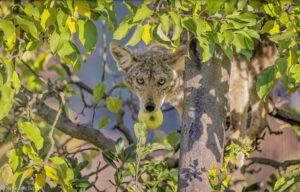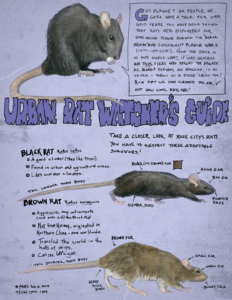Fabled as a wily shape-shifter and trickster, the coyote’s latest magic trick has been turning cities into habitat, and San Francisco is one of its latest acts.
Coyotes may have evolved in the plains and deserts of Mexico and North America, but they’ve rapidly expanded their range and are now making new homes for themselves in some of the largest urban centers, including Chicago, Vancouver, Los Angeles, and now San Francisco. San Francisco has seen a small but steady increase in the coyote population since they first appeared in the Presidio and Bernal Heights in 2001. Earlier this spring, coyote pups showed up in Golden Gate Park, sparking national attention and trail closures to protect the dens. San Francisco animal control estimates at least 15 individuals reside in city limits. Coyote hotspots include Twin Peaks, Lake Merced, Diamond Heights, Glen Park, Glen Canyon, Lands End, the Presidio, and Golden Gate Park.
“Coyotes are all over the city, in every neighborhood,” said San Francisco Animal Care and Control’s Lt. Le-EllisBrown.
This is the first in a series of BayNature.org stories about our urban coyotes, where we’ll explore how Canis latrans got here and how it’s adapting to city life. Coyotes are hardly the first species to find suitable habitat among humans — raccoons, opossums, and bears also like to take advantage of all the waste we produce. But the San Francisco coyotes have a unique story to tell about how cities can be a bridge connecting rural populations. Quite literally a bridge, as it turns out.
Bridging the divide
In 2003, the Presidio Trust partnered up with Dr. Ben Sacks and Dr. Holly Ernest, from UC Davis’s School of Veterinary Medicine, and wildlife ecologist Dr. Erin Boydston of the US Geological Survey to learn more about the Presidio’s latest canine addition. Through radio-collaring and extracting the DNA from a coyote caught in the Presidio, these researchers found that the San Francisco coyotes originated from populations north of the Golden Gate Bridge, and not from the Peninsula, as one might assume. They must have crossed the Golden Gate Bridge to get there.

California State University graduate student Katherine Marquez also found that San Francisco serves as a link between northern and southern populations, which historically have been genetically distinct. Marquez sampled a coyote in Lake Merced, on the southwestern edge of the city, that was related to the southern population, not the northern one. The genetic similarity in San Francisco’s urban coyotes also suggests that this population is rather insular, supporting theories that California coyotes aren’t too fond of leaving their natal habitat. Once a city coyote, always a city coyote.
Just how the northern coyotes got across the bridge leaves much to the imagination. Sacks and his group believed the coyotes came on their own, without hitching a ride with anyone. That idea was proven possible in 2004 when a coyote was spotted on videotape trotting across the Golden Gate Bridge.
Other methods of getting here seem unlikely. Coyotes are good swimmers, but they probably can’t make it across the treacherous currents of the San Francisco Bay. The only other land route would take a coyote over 250 km, circumventing the Bay-Delta Estuary and moving through the South Bay Hills population. Sacks and his group found it “especially unlikely” that coyotes utilized this jughandle approach to reach San Francisco.
The advance from the north is a bit surprising because historically the southern border has had the denser population. It wasn’t until coyotes began to recolonize Marin County, well after the Golden Gate Bridge was built in 1933, that they kept moving south, using the bridge as a highway of their own.
Coyote colonization
A handful of studies have begun to reveal how coyotes manage to live within urban landscapes, but it’s still unclear to scientists what prompts some coyotes to colonize cities while others remain on the periphery. Coyote specialist Stanley Gehrt, who directs the world’s longest-running urban coyote study in Cook County, Illinois, says that coyotes move into cities because of territorial pressure. Known as “land tenure,” older coyotes force out the youngsters who have yet to establish their own territory. When young coyotes leave their packs, usually after their first or second year, they embark on a journey to find vacant habitat to claim as their own.
In a phenomenon similar to sprawl, as coyote populations thrive, more and more young coyotes venture off in search of available territory, leading them into unoccupied suburbs and cities.

Since they’re a generalist species, capable of adapting their diet and lifestyle to a range of environments, coyotes can call any place home, even if it’s concrete. However, urban coyotes are still wild and prefer more natural areas, sticking to woodlots, canyons, open parks, and golf courses, and choose to avoid people and their residential and commercial areas.
It seems that the Golden Gate Bridge has upheld San Francisco’s reputation as an open and green city, connecting habitat and helping to spread the gene-flow love from north to south, rather than fragmenting wildlife populations like so many man-made structures do.
This is the first in a BayNature.org series on urban coyotes. Come back next week for Part 2: Survival 101 for the urban coyote.
Courtney Quirin is a Bay Nature editorial intern who has studied urban coyotes extensively in a graduate degree program.





